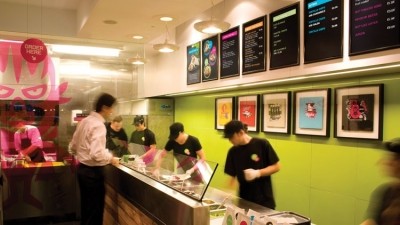How to crowdfund for a restaurant successfully

Previously seen as a more viable option for a number of ambitious start-ups who were refused funding by banks, crowdfunding has now gone mainstream with established companies like River Cottage, Brewdog and Tossed joining new-comers such Thai pop-up restaurant venture Som Saa choosing to raise finance in this way.
But while crowdfunding is now a popular choice among hospitality businesses (this year £50m has been raised through a range of businesses on the Crowdcube site alone) the route hasn’t been a smooth one for some and there are lessons even successful operators have learnt along the way which may have led to changes if they did it again.
Here are BigHospitality’s four steps to successful crowdfunding
Step one: Ensure crowdfunding is for you and your business
Crowdfunding came into its own about six years ago when banks started to tighten lending, but, as Mark Tenzer, partner at accountancy firm Jeffreys Henry says, its primary function as an alternative funding method to set up a business has evolved. Now many established operators are also using the format to grow their business.
“The benefit is that overall it’s a relatively cheap and fast form of financing for individuals compared to loans and debts and to all intents and purposes if it does fail, both those asking for investment and making investment can walk away relatively unscathed,” he says.
“But since we’ve seen some of the larger names, like River Cottage and Chilango, use it the function has changed.
“These companies don’t need to crowdfund, they can easily go to the bank and get funding. What they use it for is to tap into an already loyal customer base who are emotionally involved with the brand.
“By enabling your customers to make a small investment in your brand you make your network larger. If you’re clever you can also get some good press around it. Chilango did it very well when they ran their campaign.”
Christian Mouysset co-owner of Hummus Bros, says he was surprised at the buzz created by the crowdfunding campaign he and co-owner Ronen Givon launched on Seedrs earlier this year and says it would prompt him to run a similar one even if he had funding through different means.
“I had completely underestimated that element of it before doing it the first time. People become evangelists of your brand, they tell their friends to go and have lunch with you because they want them to see what they’ve invested in. They really get involved in the business,“ he says.
For first-timers to the industry looking to open their first permanent restaurant or bar, Tenzer recommends looking at a range of funding options, not just using the crowd as it may not give the support needed.
“Although it’s easy to see the attraction of crowdfunding as a magic solution, don’t discount other options, particularly angel investors and private equity investors who have experience of the market,” he says.
“You may have run a pop-up restaurant and now want to launch permanent one, but It’s very difficult to run a permanent site. An angel investment can step in and deal with any problems that may arise or can give guidance around planning, that kind of thing.”
Step two: Draw up a strong business plan
Setting up a crowdfunding campaign may seem relatively easy and risk-free, but remember the onus will be on you to lead the business and make the decisions when you reach your funding target.
“A serial, or traditional investor would also look at your financials and return on investment before investing, but in crowdfunding individuals are investing in you and your brand so you should have a strong business plan and financials before you launch anything,” says Tenzer who warns would-be restaurateurs to allow for more cash than needed to simply ‘launch’ a restaurant.
“A lot of your projections will be based on month-on-month growth, but remember in the restaurant sector you can have dead weeks, or even months, so you have to plan for that,” he says.
“The reason some new restaurateurs fail is because they are trying to launch on a shoestring and don’t have enough working capital. They have no buffer in place if they hit a dead month and if you can’t get funding quickly you close down quickly. Make sure you raise enough cash to see you through the first 12 months as well as to set up.”
When you do have your business plan in place and are ready to launch your crowdfunding campaign, Luke Lang, co-founder & chief marketing officer at Crowdcube, recommends taking some time to get the pitch right.
“Investors want to see something that sparks their enthusiasm,” he says. “Show you have a great idea with clear market potential and a strong team behind you. Outline what makes the business unique. Tell them your own story – your history and expertise, why you decided to open a hospitality business, and what excites you about it.
“We’ve found that people are more likely to invest in a business if the proposition is something they’re already passionate about or if it’s just too interesting or compelling to ignore.”
Lang’s top tips are to have a ‘clear pitch’ that is not ‘misleading in any way’.
“Don’t be over-ambitious with your target or put people off by overvaluing your business; ask for only the amount you need, and explain why you need it and exactly how you’ll spend it,” he says.
“Explain your strategy for growth, and prove that the business is scalable. Investors will want to know about the potential for return on their investment, so it’s essential that you can outline how and when that could happen.”
Step three: Choose the right platform
Crowdfunding roughly falls into two main categories - rewards based where investors are given an incentive such as a free meal in return for a donation and equity based where investors buy a share of the business.
Tenzer recommends researching the terms and conditions of each crowdfunding site you are considering before signing up because each will offer something different. Some will allow you to deal directly with your investors, for example while others will act as a go-between.
“If you choose the option where investors get an equity share in the company there will be a certain level of compliance around that,” warns Tenzer. “All of a sudden you have 100 investors in your company who will all need a shareholder certificate issuing and updating the share table can be a bit of a nightmare. There may be a couple of investors who want to be more involved and will have an opinion, so be prepared for that.”
“Seedrs has a nominee structure where the investors invest in a nominee company and then that invests in the restaurant whereas with Crowdcube you have a hundred odd individual investors that you have to deal with directly.
“There are differences, but there’s not one that’s better than the other. You need to work out what’s right for you and your growth plans.”
Mouysset agrees that it is worth spending some time researching the platform. For his Hummus Bros. expansion campaign he chose Seedrs and he says he would consider using it again in the future.
“I was impressed at how they managed the process. I haven’t used other platforms so it’s hard to compare, but I certainly think it’s important to choose the right partner. It’s really a partnership, it isn’t a question of you giving it to the platform and they get on with it. You both have to work really hard at it, what I liked about Seedrs was they could advise you,” he says.
Step four: Set a realistic funding target
While it is prudent to raise enough money to set up a restaurant and allow a 'buffer' for any unforeseen costs or slow months in the first year, Crowdcube's Lang advises crowdfunders to be realistic when setting a funding target.
"Don’t be over-ambitious with your target or put people off by overvaluing your business; ask for only the amount you need, and explain why you need it and exactly how you’ll spend it," he says.
Hummus Bros' Mouysset said he decided to only raise half of his £500k funding target for expansion through crowdfunding as he wasn't sure how the campaign would go.
"I saw crowdfunding as a great platform to get awareness around the company. We got lots of coverage in the press which created word of mouth around the brand and got more people coming through the doors, but it wasn't the only way I wanted to work," he says.
"For us it was better to get £250k from people who we knew who would also bring more to the table than just the money, then the rest through crowdfunding. We already had the £250k committed before we launched the campaign which gave us a good start."
Mouysset also had investors primed to support his campaign when it went live and would encourage others to do the same 'to get the ball rolling'.
"Before you launch your campaign speak to people – friends, family or whoever who’ll do that first investment and get them to commit ahead of time. Then, when you launch you have the first 10 to 20 per cent to really make sure that when it becomes public people see it and are more likely to invest."
It was a strategy that evidently worked - Hummus Bros ended up raising £450k, £200k over its original target.
"We hit the target in three weeks, but decided to keep it open for the full 60 days," says Mouysset. "I'd definitely do it again. You have to work at it, but it can be very worthwhile for you and your business."

















